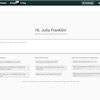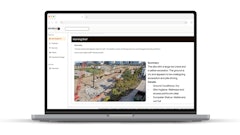By Kimberly Kayler, CPSM, CSI, Contributing Writer
In tough economic times, marketing is one of the first areas where many firms cut time and resources. But what these firms don't realize is that in challenging times and competitive conditions, marketing is more important than ever. While your competitors are cutting back their marketing efforts, increasing yours will give your firm a unique opportunity to stand out in the industry. Below are some tips and techniques on how to adapt your marketing strategy to today's challenging economy and make the most of your marketing dollars.
Focus on your customers
When sales are down, we tend to focus on obtaining new business. But what about the clients that have been with your firm for decades? Check in with past or existing clients. This has always been a good practice, but it is especially important during challenging economic times. Even if a particular client doesn't have immediate work for you, they will appreciate that you have consistently been in touch with them, not just when an RFP is out on the street. Now is also a good time to survey your clients and find out how they perceive your firm. You may be surprised to find out what clients see as your strengths and weaknesses. If a client is pleased with your service, ask for a letter of a recommendation. If a client is less than satisfied, find out what you can do to remedy the situation.
Although this may seem like a time consuming task, it can easily be accomplished by dividing up your client list and dedicating time each week to make calls. Time is better used marketing to existing and past clients than spending hours trying to market to new clients who have no familiarity with your firm and are wondering why they never heard from you when the economy was thriving. Without fail, when you spend time marketing to your existing client base, you will come back with projects.
Do a little housekeeping
When business slows, firms finally have time to get to those items that are important but were often overlooked and pushed to the bottom of the to-do list when business was thriving. Use this time to refine services, conduct research, develop new products or services, or earn certifications.
Now is the time to determine how you can streamline your business or what opportunities there may be for expansion. Many of these activities can be performed internally with your existing staff. At the same time, consider adding resources to strengthen your firm. Talent supply exceeds demand in a down economy, so take advantage of talented engineers, project managers and business development professionals seeking opportunities in your market.
You can also use this time to expand your message. Analyze what has helped your company withstand economical challenges and include that information in your message to clients. This will show customers how you have protected your company's reputation and how they can expect the same service.
Select your customers
As mentioned above, marketing to your existing client base is essential; however, not all clients are created equal. Evaluate your clients and determine who is costing you too much time and money with little ROI.
Firms are often hesitant to turn down any work, especially when sales are low, but by using customer segmentation, you can prioritize your clients and better service those who are aligned with your firm's goals. Customer segmentation is the process by which you organize your clients with regards to their needs and your services. Rate your clients in terms of how they perform based on what you value. Many find it simple to group the tallied numbers at the end into three categories - A, B and C clients. You will likely find your effort is going toward clients that are slow to pay, haggle you on price and don't appreciate the value you bring. Then you are neglecting or not focusing enough time on your A clients. And A clients are more likely to bring you repeat work and provide the type of working relationship you are seeking.
By participating in this customer segmentation exercise, you will have a customer action plan that guides standard operating procedures for all clients. This plan improves customer service by enabling you to better focus on tasks and communication through more effective allocation and utilization of resources. This directly links customer behavior and their potential profitability to customer loyalty.
Learn to say no!
You've heard it before, but quality is more important than quantity. During tough economic times, firms usually resort to pursuing any and every RFP. If you spend hours responding to RFPs each week but have no new work to show for it, you have wasted time and resources that could have been better utilized elsewhere.
This is why it is important to have a Go-No Go strategy in place that aligns with your firm's strengths and goals. This strategy will also help you determine whether or not your firm can be competitive and should spend the time and money to develop a proposal. Proposal development should never exceed 3 percent of the potential win. If you have to spend more than that to prepare the proposal, you need to rethink pursuing the project.
Other key factors to keep in mind when developing a Go-No Go strategy include whether or not the client knows and likes you and vice versa. Also, you need to determine if you have the resources and experience to successfully complete the job within the negotiated fee. If a project doesn't meet the criteria in your Go-No Go strategy, it is best to walk away and focus on pursuing work that you can and want to win.
Be nice
While being nice and respectful may seem like an obvious part of your marketing efforts, kindness is a rarity in today's stressful environment. An easy way to help your firm stand out in the marketplace is to bite your tongue now and again and just be nice. At the end of the day, people want to work with people they like. Despite the extra pressure you may be under at this time, going the extra mile to be nice and positive to your clients, potential clients, colleagues and employees will pay off in the end. Clients will want to work with you and employees will want to work for you, which will overall position your firm for success. Recognize your loyal clients. A simple thank you goes a long way, and referrals are crucial now more than ever. Spread the word for your clients, suppliers and contractors, and they will return the favor to you two-fold.
Invest in marketing
Studies show that a consistent presence in the marketplace now will play dividends in the future. In fact, marketing dollars invested in a down economy are actually more valuable than those spent in a good economy as you gain greater market presence and are seen as a strong, solid company. Now is also an ideal time to experiment with new marketing techniques, such as social media. Create a presence for your firm on Twitter, LinkedIn, Wikipedia and Facebook. By following the marketing strategies above, you can better position your firm to withstand a difficult economy and be prepared for the upswing.
Kimberly Kayler, CPSM, is president of Constructive Communication, Inc., a public relations firm founded in 2001 that specializes in the design and construction industry. She is the author of Leading with Marketing (www.leadingwithmarketing.com). Kayler can be reached through www.constructivecommunication.com.



















